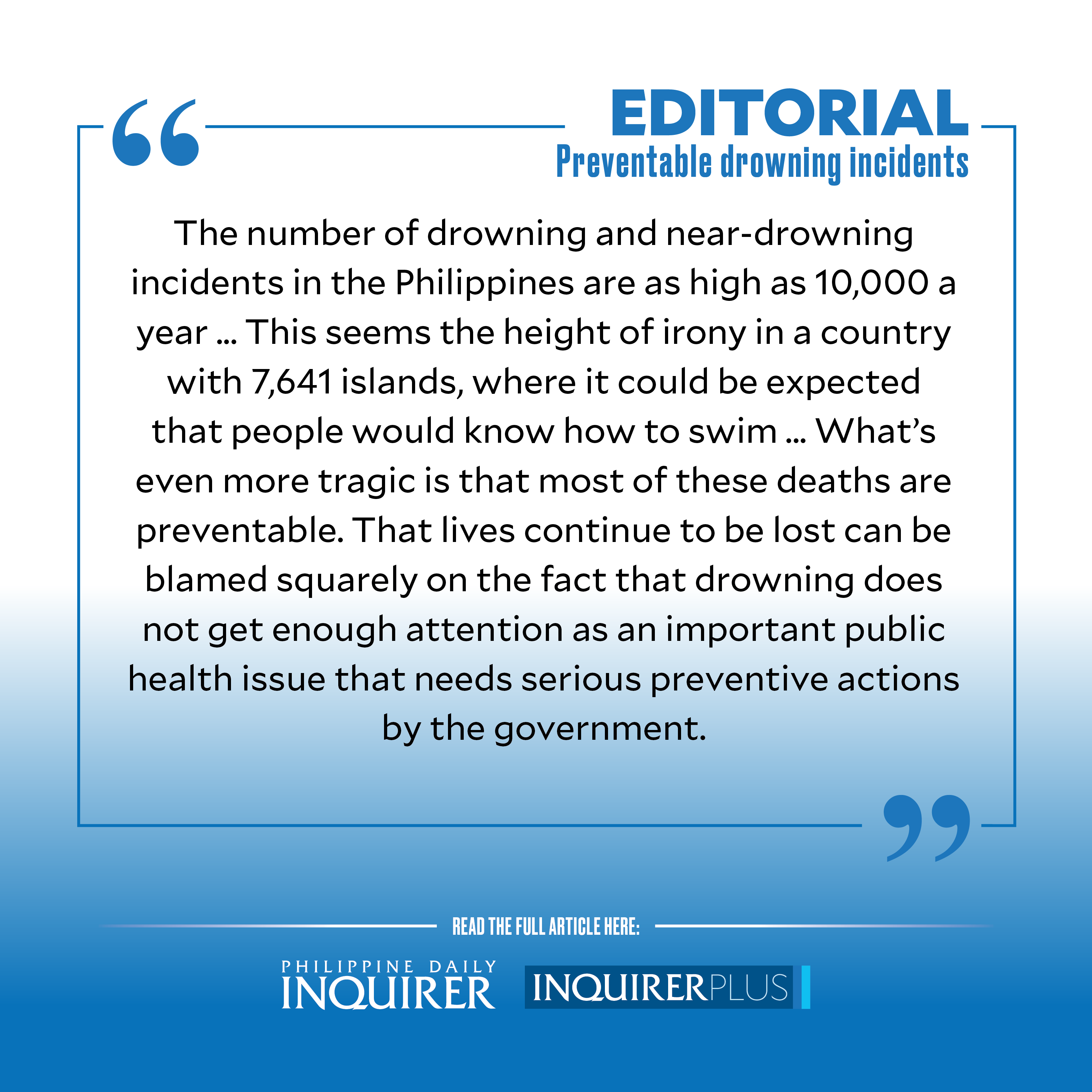
The extended Lenten break last week was marred by the tragic death of 72 Filipinos, including 23 minors, who drowned in beaches and resorts across the country.
According to Col. Jean Fajardo, spokesperson of the Philippine National Police, the casualties included “children left unattended, [others who] were drunk, and those who pulled each other down and drowned together.” Fajardo reminded families to “take care of their children when they’re swimming,” and to avoid venturing into the “deep part of the sea.”
Such common sense reminders have apparently gone unheeded in this archipelagic country where almost 2,350 individuals drowned last year, according to the Philippine Statistics Authority. Close to half of them, or 44 percent, were below 19 years old, while another 13 percent were under the influence of alcohol. The figure is grossly underreported, according to the Philippine Life Saving Society (PLSS), a volunteer-based training organization championing a culture of drowning prevention in the Philippines. The number of drowning and near-drowning incidents in the Philippines are as high as 10,000 a year, it said. This seems the height of irony in a country with 7,641 islands, where it could be expected that people would know how to swim. Or at the very least, be extra conscious of the ever present danger of drowning, thus avoiding such risky behavior as swimming while intoxicated.
Yet not enough Filipinos are equipped with these life skills, confirming the World Health Organization’s (WHO) description of drowning as a “silent epidemic,” and one of the leading causes of death globally for children and people aged 1 to 24. More than 90 percent of the estimated 236,000 drowning deaths every year occur in low- and middle-income countries, including the Philippines, with children under five at the highest risk, according to the WHO. What’s even more tragic is that most of these deaths are preventable. That lives continue to be lost can be blamed squarely on the fact that drowning does not get enough attention as an important public health issue that needs serious preventive actions by the government.
Understandably, according to Dr. David Meddings, who was involved in the WHO’s work on drowning prevention, more resources and focus have been allotted to infectious diseases that kill more children below five years old. But in especially vulnerable countries like the Philippines, that focus needs to be expanded to other issues such as drowning. The WHO has fortunately laid out low-cost, evidence-based, and practical solutions that policymakers can immediately adopt to save lives. These include installing barriers to control access to bodies of water; teaching swimming, water safety, and safe rescue skills, and enforcing safe boating, shipping, and ferry regulations since many drowning deaths are caused by boats that capsize or malfunction.
The PLSS, for its part, has formulated the Philippine Drowning Prevention Plan that seeks to cut drowning and near-drowning incidents by half, to a maximum of 5,000 by 2025. Among its top recommendations that local and national governments can act on with urgency is to integrate a swim and survive program to the education department’s K-to-12 program to ensure that swimming can be learned as early as possible, especially by those living near high risk locations like near public leisure pools, resorts, rivers, lakes, beaches, and surfs. Already a bill has been filed at the House that would make swimming a subject in the basic education curriculum, “as an integral part of the overall strategy to reduce the incidence of death by drowning during natural calamities or recreational aquatic activities.”
The PLSS also recommended that those who teach swimming and aquatic sports be trained as well in drowning prevention and aquatic emergency response. Of particular concern are the island communities in the path of typhoons and other natural disasters that elevate the risk of drowning. Also being pushed is the implementation of an intensive community education program that can lead to the installation of proper warning signs against potentially hazardous aquatic environments, such as riptides and sudden changes in water depths or potential rough seas.
It would also do well for Filipinos to ensure that their vehicles are seaworthy. As noted in the past week, incidents of near drowning occurred when boats capsized in Romblon near Bonbon Beach and in Matnog, Sorsogon, where 13 and 11 passengers were rescued, respectively.
It may take years before these recommendations can be fully rolled out, but already, individual steps can be taken to reduce the risk of drowning. These can start from learning how to swim, and being acutely aware that behind our beautiful beaches, pools, rivers, and lakes, the danger of drowning lurks and must not be taken lightly. As PLSS president and chief executive officer Arne Navarra noted, anybody can drown, but no one should.

